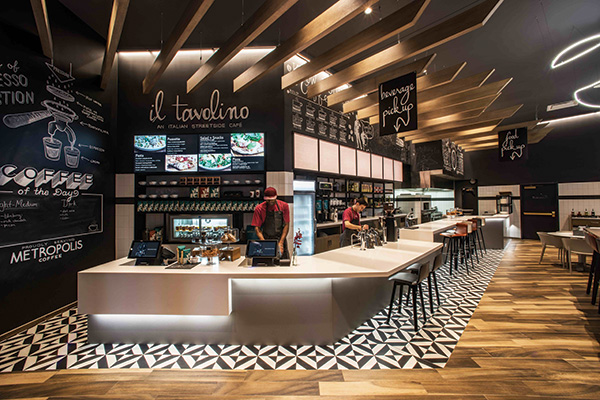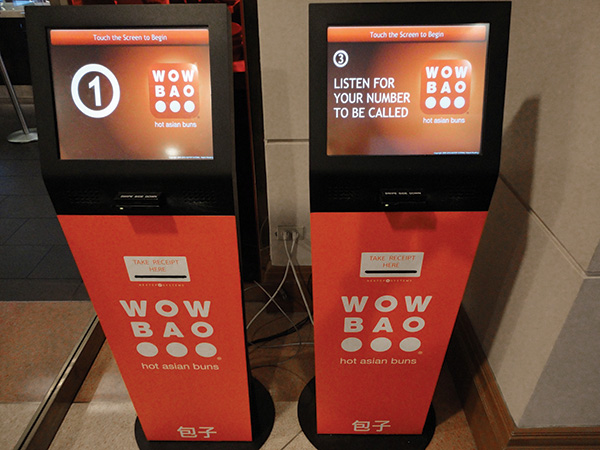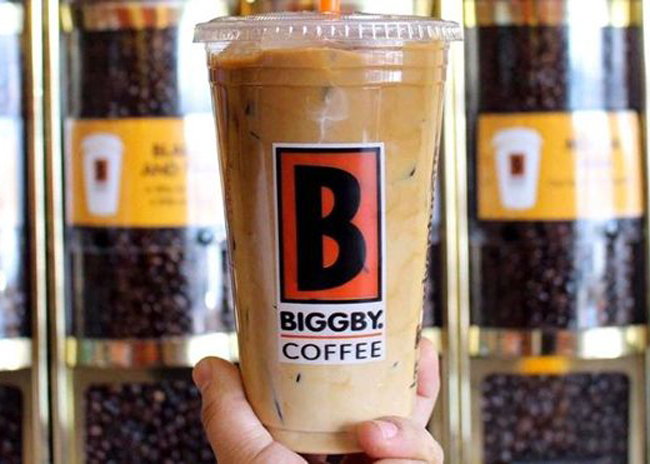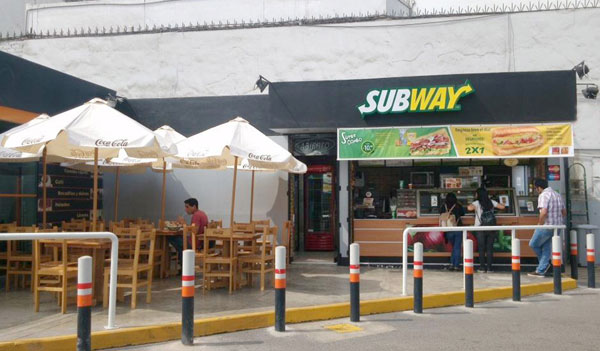 Il Tavolino in the Conrad Chicago Hilton hotel features ordering tablets. Photos courtesty of Puccini GroupCustomer-facing technology requires savvy design decisions.
Il Tavolino in the Conrad Chicago Hilton hotel features ordering tablets. Photos courtesty of Puccini GroupCustomer-facing technology requires savvy design decisions.
Customer-facing technology is not a one-size-fits-all undertaking. For one thing, operators should tailor the system to the brand promise. For another, the type of technology chosen — kiosks, counter tablets or tabletop tablets — will have an impact on layout and design. So, the decision of what technology is used, and how, should be well thought through.
“The restaurant should have a clear idea of its goals when introducing technology to the guest experience,” says Rafe Gabel, vice president of Restaurant Operations at the Puccini Group, a hospitality design firm based in San Francisco. “These goals can range from saving labor to improving the guest experience.”
One goal might be for throughput: to turn tables faster. Another might be to improve the guest experience by providing the ability to easily customize orders. Yet another might be to provide the customer with the story behind the source of farm-to-table or specialty products, nutritional data, or allergen information. Still another might be to reduce the need for staff. Each goal has unique aspects to consider. The goal dictates the technology and the design.
The impact on physical space in the front of the house is twofold. First is the type of equipment. Standing kiosks are generally confined to one area on the floor. Tablets or touch screens require counter space. The second consideration is the management of guest flow. The objective is to keep lines moving quickly and seamlessly. If there is counter ordering, this line should be separate from a kiosk line; however, the pickup area in most cases serves both.
Scott Gamble, senior foodservice designer at WD Partners, a global firm that focuses on customer experience, says restaurant design must take into consideration the operational space for both the kiosks and the pickup areas. “There should be a balance to accommodate customers ordering online, at in-store kiosks and traditional counter service,” he says. “The flow should give guests entering the space a clear path to bypass the order line and proceed to order kiosks and/or the pickup area. All these areas should be easily recognizable.” He adds that it is also necessary to consider how to create a clear path for exiting customers.
Gamble doesn’t believe that customer-facing technology will necessarily change the footprint. “I don’t think the footprint of restaurants increasing or decreasing is necessarily a result of technology but more a result of value engineering and building costs,” he explains. “There is more likely a balance of trading space once used for seating that now is designated for technology. Those seats previously needed for dine-in customers have been traded for kiosks.”
When designing for new construction, Gamble believes it’s relatively easy to plan and program in the space requirements for order kiosks and pickup stations. The challenge comes when an operator is adding kiosks into an existing location and incorporating them so they do not look and feel like an afterthought.
Gamble advises, “When considering the flow and moving customers through a space, the goal is to prompt them to choose either a path to the ordering line or proceed to the online pickup area.” The ordering line could be at a kiosk or at the counter. He adds, “The traffic needs to be fluid to reduce congestion or stopping points and create continuous flow through the space.”
Ideally, Gamble notes, dining areas are separated from aisleways. “Sometimes they have to be incorporated within the area due to space limitations or retrofitting into existing space,” he says. “If this is the case, the goal is to prevent customers from lingering in these areas and reduce the potential of creating a negative dining experience.”
Impact on the Back of the House
Generally speaking, kiosks do not have a significant impact on space in the back of the house. Orders come in to the kitchen in sequence, regardless if they are placed at a counter, at a kiosk or by phone.
The method of communicating orders from the front of the house to the back may change, however. Chefs and cooks have traditionally worked from paper order tickets that are stuck on a rail. With kiosks, the process may be a screen-to-screen transfer providing the chef with a digital display. This may require training for staff. “Proper onboarding and training on the new technology for all employees is something that needs to be considered,” Gabel says.
Holding equipment may need to be increased, usually as a result of mobile orders, not in-house, which are picked up immediately. “Holding equipment definitely has an increased presence in most companies adopting mobile-ordering systems,” Gamble says. “It’s a combination of holding product at the front serving line, backup product and holding customer orders until time of pickup. The main focus is to keep the product moving through these holding methods to ensure quality and freshness.”
Impact on Staffing and Tipping
According to Gabel, exercises can be conducted to see what dining-related tasks staff members still need to perform. This data can then be used to time and monitor how many of those duties can be performed in one hour with X number of guests. “This will allow you to scale your schedule with fewer employees,” he says.
Gabel points out that staff in a high-tech order-and-payment environment are a “different kind of employee” from the traditional counter staff. “You’re looking at more of a retail employee,” he says. “You need someone who understands enough to respond when someone says, ‘Does this have nuts on it?’ Before, if someone didn’t have restaurant experiences, they would not be hired. Now, operators look for experience, like having worked at the Gap for five years.”
Kiosks can reduce the need for order takers at the counter. However, there is still the need for one or more cashiers, depending on traffic. Some operators employ a host or an ambassador, also known as a floater, to work in the front of the house either to help with technology or to manage flow by directing customers to tables, to ordering lines or to a cashier.
Technology spurs one question: to tip or not to tip? Kiosks are influencing the practice. While some systems will give a prompt to add a tip, the user can bypass it.
No tipping results in changing hiring practices. Honeygrow’s Director of Operations and Training Jay Denis says tipping is not part of their business model. “Everyone is paid a fair and competitive wage, and we give people merit-based incentives on their earnings,” she says.
The Minimalist Approach
Gabel believes that the ability to go wireless is the best part of the new technology. “Before, you had to design around the ability to run phone lines and have outlets so you could have a host stand with a big, clunky PC in the middle of your dining room,” he says. “Now, you can have an elegant footprint for these needed items. Docking stations can be located at numerous locations of the restaurant, which allows for more efficiency and flexibility.”
By getting away from big stations and hard wiring, Gabel says, the mothership can live off-site, tucked away in a downstairs office, and everything can be done wirelessly. “There is very minimal wiring needed at all. This is versus needing a phone line and a stationary piece of equipment.” He adds, “[Wiring] dictates the flow of the restaurant. When everything can be moved, it just becomes four walls that you can play with however you like. Servers can take the POS with them tableside. It improves efficiency instead of having everybody piling up in one center location to order.”
Improving the Airport Experience and Access to Beer
 Wow Bao’s kiosks boast facial-reconition technology. Photo courtesy of Wow BaoOTG Management, based in New York City, has launched an innovative program at Jet Blue Terminal 5 at JFK Airport. There are 16 seat clusters spread through the 26 gates. Each seat has a place to charge phones or computers and a screen that contains a food menu in addition to the usual flight information. Travelers order, pay and receive a delivery time. The food is delivered to their seat. Rick Blatstein, founder and CEO of OTG, says the concept is designed to bring humanity back to dining in an airport.
Wow Bao’s kiosks boast facial-reconition technology. Photo courtesy of Wow BaoOTG Management, based in New York City, has launched an innovative program at Jet Blue Terminal 5 at JFK Airport. There are 16 seat clusters spread through the 26 gates. Each seat has a place to charge phones or computers and a screen that contains a food menu in addition to the usual flight information. Travelers order, pay and receive a delivery time. The food is delivered to their seat. Rick Blatstein, founder and CEO of OTG, says the concept is designed to bring humanity back to dining in an airport.
Kiosks are now for more than ordering food. WD’s Gamble says, “Self-serve beer systems are growing in popularity due to the elimination of the bartender and the associated labor costs while achieving a desired volume greater than a bartender’s capability.” Automated beer dispensers reduce lines and waiting times as well as give the customer more control.
In the Cincinnati Reds ballpark, Delaware North Sportservice has installed 20 self-serve beer kiosks for thirsty sports fans. Stored-value cards are available in Cincinnati retail stores and can be used throughout the season. The customer taps his card next to the beer he wants and is charged for the pour, similar to pumping gas.
Delaware has also set up four kiosks in the main concourse that allow fans to order and pay for food offered at six themed concession stands. After completing the transaction, consumers go to an express pickup station for their order.
The Boise TechMall in Idaho sports a self-serve beer and wine kiosk at a location called the Boise Hot Spot. Techies get a RFID card from staff, make their selections and fill their glasses.
Where Will It Go from Here?
Gamble predicts a healthy future for customer-facing technology. “I see this as a growing trend that will continue to gain popularity as the technology improves. The goal is obviously to increase sales, but it also improves the customer experience and keeps them engaged,” he says. “We’re all creatures of habit, and moving forward, it will keep getting easier to purchase our favorite meals from our favorite restaurants.”
It’s up to the restaurants to design the technology experience so that they can best deliver on their brand promise.
Case Study: Prep Transparency at Honeygrow
Honeygrow, a fast-casual concept based in Philadelphia, wants its customers to see the food being made. The chain features made-to-order salad and stir-fry, both of which can utilize a certain amount of theater in the prep. For this reason, the chain chose to place its touch-screen kiosks on a counter against a nearby wall. The low wall faces the kitchen so that customers can watch when they order. The kiosk area is separated by a glass partition from the prep area.
“We want our guests to have a very kitchen-facing experience,” says Jen Denis, director of operations and training. “We want them to see how transparent we are about where food comes from and how it is handled.” There are four to six kiosks, depending on the size of the location and how much business is forecast. Honeygrow has just opened its 18th location, in Boston, and is about to open its 19th, in Chicago.
The goal of the technology was established by founder Justin Rosenberg, who wanted to increase throughput and put the power of customization in the customers’ hands. If someone has allergies or dietary restrictions, they can place their order in private. If anyone has a problem with the technology, there is a Honeygrow ambassador there to help.
Guests order exclusively through the kiosks. The only counter person is a cashier. Credit cards and Apple Pay can be used at the kiosks, while cash and gift cards are handled by the cashier. The cashier also helps expedite orders.
Honeygrow uses technology that mimics an old-fashioned system to alert customers that orders are ready. Called “split flop” signage, it looks like old-fashioned train signs that would flip letters and numbers for departures and arrivals. “We love the authenticity of mechanical things,” Denis says. “And we still love old-fashioned things, so sometimes we take technology and find a way to incorporate it that is a little homey.” During off-peak times, the system understands the gap in order frequency and displays marketing messages. If a customer isn’t paying attention, the cashier will call out the order.
Case Study: Wow Bao’s Kiosks Are Looking at You
Kiosk ordering has become mainstream at Wow Bao, a Lettuce Entertain You Enterprise (LEYE) chain that started in Chicago and now has nine units and four hotels serving its products. The menu star is a selection of baos, steamed Asian buns filled with a variety of proteins, Thai curry or veggies. The concept has been using kiosks for ordering and payment since 2009.
Geoff Alexander, vice president at LEYE and managing partner of Wow Bao, explains that they followed two options when designing their customer-facing technology. Some of the units are in malls, which allows the company to place the kiosks just outside the entry door. In crunch times, this keeps the line at the kiosk separate from the line at the counter.
In other configurations, the kiosks are inside, nearer to the cashier. Alexander says that the external design works better in terms of handling flow. “We prefer it because you can order, walk in and grab your food, and get out,” he says. “It doesn’t affect your inside layout. It doesn’t affect your queuing. It doesn’t affect anything.”
Three of the five company store kiosks now boast facial-recognition capability. When a customer completes an order, the screen asks if she’d like to have the order remembered. She can choose to have it saved by phone number or facial recognition. With the latter, a camera takes a photo in eight seconds. The next time she visits the kiosk, it will recognize her and pull up her last four orders.



